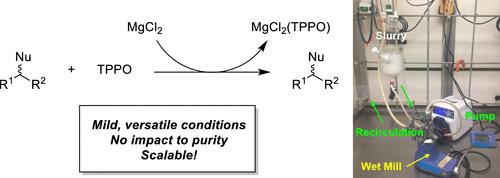当前位置:
X-MOL 学术
›
Org. Process Res. Dev.
›
论文详情
Our official English website, www.x-mol.net, welcomes your feedback! (Note: you will need to create a separate account there.)
Scalable Protocol for Removing Triphenylphosphine Oxide from Reactions Using MgCl2 and Wet Milling
Organic Process Research & Development ( IF 3.1 ) Pub Date : 2024-05-07 , DOI: 10.1021/acs.oprd.4c00071 Eric G. Moschetta 1 , Benoit Cardinal-David 1 , Travis B. Dunn 1 , Moiz Diwan 2
Organic Process Research & Development ( IF 3.1 ) Pub Date : 2024-05-07 , DOI: 10.1021/acs.oprd.4c00071 Eric G. Moschetta 1 , Benoit Cardinal-David 1 , Travis B. Dunn 1 , Moiz Diwan 2
Affiliation

|
We report a scalable protocol for removing triphenylphosphine oxide (TPPO) from Mitsunobu coupling. In the protocol, solid MgCl2 reacts with TPPO in solution, forming an insoluble solid complex that is easily removed from the reaction mixture by simple filtration. Our development work revealed that regeneration of the surface of the particles through grinding was key to exposing more MgCl2, thereby increasing the rate of complexation of MgCl2 with TPPO. As a result, we implemented wet milling to provide the shear necessary to grind the particles and to provide a more robust strategy for scale-up of the protocol. Introducing wet milling and MgCl2 did not generate additional impurities in the studied reaction. Having established the protocol in development, we performed an appropriate scale-down reaction to determine the turnover number required to remove TPPO to a desired level at scale. Ultimately, we successfully demonstrated our wet milling protocol on a 14 kg scale of the Mitsunobu coupling, removing the TPPO in the crude mixture from 37.18 to 0.15 area % (HPLC) and to 0.6 wt % in the isolated product. Our protocol could be applied to other reactions in which TPPO is a byproduct, demonstrating its versatility and potentially expanding the scope of such reactions into later phases of pharmaceutical process development.
中文翻译:

使用 MgCl2 和湿磨从反应中去除三苯基氧化膦的可扩展方案
我们报告了一种可扩展的方案,用于从 Mitsunobu 偶联中去除三苯基膦氧化物 (TPPO)。在该方案中,固体MgCl 2与溶液中的TPPO反应,形成不溶性固体复合物,通过简单过滤即可轻松从反应混合物中除去。我们的开发工作表明,通过研磨再生颗粒表面是暴露更多 MgCl 2 的关键,从而提高 MgCl 2与 TPPO的络合速率。因此,我们实施了湿磨,以提供研磨颗粒所需的剪切力,并为方案的放大提供更稳健的策略。在研究的反应中引入湿磨和MgCl 2并没有产生额外的杂质。在制定开发方案后,我们进行了适当的缩小反应,以确定将 TPPO 大规模去除至所需水平所需的周转数。最终,我们在 14 kg 规模的 Mitsunobu 偶联上成功演示了我们的湿磨方案,将粗混合物中的 TPPO 从 37.18 面积% 去除至 0.15 面积% (HPLC),并将分离产物中的 TPPO 去除至 0.6 重量%。我们的协议可以应用于以 TPPO 为副产品的其他反应,展示其多功能性,并有可能将此类反应的范围扩展到制药工艺开发的后期阶段。
更新日期:2024-05-07
中文翻译:

使用 MgCl2 和湿磨从反应中去除三苯基氧化膦的可扩展方案
我们报告了一种可扩展的方案,用于从 Mitsunobu 偶联中去除三苯基膦氧化物 (TPPO)。在该方案中,固体MgCl 2与溶液中的TPPO反应,形成不溶性固体复合物,通过简单过滤即可轻松从反应混合物中除去。我们的开发工作表明,通过研磨再生颗粒表面是暴露更多 MgCl 2 的关键,从而提高 MgCl 2与 TPPO的络合速率。因此,我们实施了湿磨,以提供研磨颗粒所需的剪切力,并为方案的放大提供更稳健的策略。在研究的反应中引入湿磨和MgCl 2并没有产生额外的杂质。在制定开发方案后,我们进行了适当的缩小反应,以确定将 TPPO 大规模去除至所需水平所需的周转数。最终,我们在 14 kg 规模的 Mitsunobu 偶联上成功演示了我们的湿磨方案,将粗混合物中的 TPPO 从 37.18 面积% 去除至 0.15 面积% (HPLC),并将分离产物中的 TPPO 去除至 0.6 重量%。我们的协议可以应用于以 TPPO 为副产品的其他反应,展示其多功能性,并有可能将此类反应的范围扩展到制药工艺开发的后期阶段。






































 京公网安备 11010802027423号
京公网安备 11010802027423号